The MGA With An Attitude
IGNITION SWITCH Keying & Internal Parts, MGA - ET-125
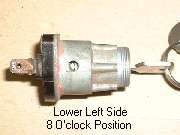
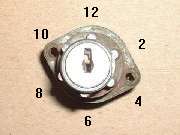
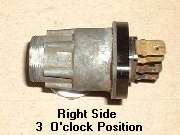
A common question is how to remove the key lock cylinder and tumblers from the ignition switch to install a new one. If you have the correct key, insert the key and turn to the "on" position. Find a hole in the side of the switch (about 3/16 inch diameter)
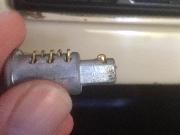 in line with bottom edge of key when in the "on" position. Inside the hole, looking between coils of a spring wire, find a brass button about 0.084" (2.13-mm) diameter. Using a probe like a fat paper clip or thin Phillips screwdriver, press this spring loaded pin in while you pull the key and drum out of the switch housing. A new switch should come apart easily. An old switch might be a tough pull if the double-D nose of the drum is stuck in the switch rotor.
in line with bottom edge of key when in the "on" position. Inside the hole, looking between coils of a spring wire, find a brass button about 0.084" (2.13-mm) diameter. Using a probe like a fat paper clip or thin Phillips screwdriver, press this spring loaded pin in while you pull the key and drum out of the switch housing. A new switch should come apart easily. An old switch might be a tough pull if the double-D nose of the drum is stuck in the switch rotor.

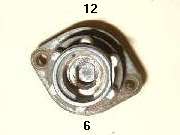
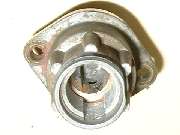
Photos above, left to right: Switch rotor with double-D hole in "on" position at 2 o'clock rotation. Switch rotor in "off" position at 12 o'clock rotation. Inside switch housing showing small bottom hole in rotor that accepts the brass locking pin.
Photos above, left to right: Lock cylinder left side with key in place, all tumblers aligned flush with top and bottom of cylinder to allow rotation. Bottom of cylinder with key and tumblers showing key inside. Top of cylinder with key and tumblers, also showing spring pockets at edges of tumblers.
Photos above, left to right: Left side of cylinder assembly with key removed, all tumblers extended downward where they will lock into the slot in the housing. Bottom of cylinder with key removed showing tumblers lowered, also showing three of the five spring pockets. Top of cylinder with key removed and tumblers lowered.
You should not need to remove the tumblers from the cylinder unless you intend to re-key the lock. In that case you would need new tumblers, and cut a new key to match, or install the proper combination of tumblers to match the new key. This job is usually left to locksmith who would have the correct parts. It may be cheaper and easier to buy a new cylinder and key set (if you do not need to match a particular key number).
Photos above, left to right: Cylinder inverted (bottom up) with one tumbler and spring removed. Top of empty cylinder (no tumblers). Bottom of cylinder with no tumblers, but with five springs still in the spring pockets. Also notice two reinforcing cross bars inside the cylinder.
To remove a tumbler, press down firmly on top of tumbler until it pops loose and moves downward to be extracted from bottom side. The two small bumps on side of the tumbler opposite the spring serve as motion limit stops within a shallow slot in the cylinder. This requires a firm push to install or remove the tumbler, but once inside they move freely within the normal working range of motion.
Although this lock was working well before disassembly, there was some corrosion inside. In particular, the springs were stuck in far end of the pockets, mired in bit of compacted oxide dust. The one spring in the picture was stretched a bit before it came loose. When cleaning after disassembly, a significant amount of oxide dust was dislodged. Over the prior 24 years of regular operation, it could have benefited from a periodic touch or graphite lube, but such may not come to mind when the thing is always working okay.
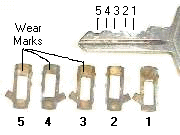
This is a 5-tumbler lock, so the numbers in picture at left represent the 5 stations on the key and the 5 matching tumblers. Notice the wear marks where teeth on the key bear against the apertures in the tumblers. The key also wears down some with use. This makes the tumblers drop slightly below the bottom of the cylinder where they might hang up in the slot of the housing. If you have to fiddle a bit with your key to get the lock to turn, this may be the problem.
If you don't have a key, you can take it to a locksmith who might make a serviceable key in less than 10 minutes without even disassembling the lock (cute trick).
If it is an original switch and has the key number on the front, Pete Groh can make you a key on an original blank. Contact information:
British Car Keys
9957 Frederick Rd.
Ellicott City, Md. 21042-3647
Phone: (410) 750-2352 Evenings - (443) 912-4740 Cell
Email: pete_groh@yahoo.com
Otherwise drill out the cylinder and tumblers starting center front with progressively larger drills until you can dig out the remains of the tumblers with a metal pick. Drill only as deep as the length of a key (3/4 inch deep). Expect final drill size of 1/4". Once all bits of tumblers have been removed, rotate the cylinder 60 degrees clockwise to align the locking pin with the access hole, then follow instructions at top of page.
|